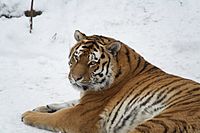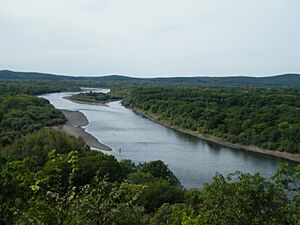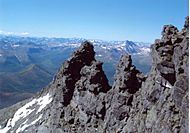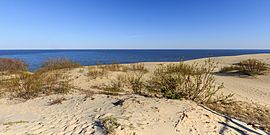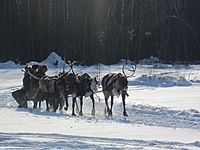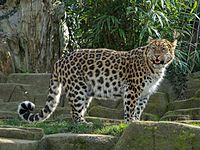Wildlife of Russia facts for kids
The wildlife of Russia is incredibly diverse! Russia is a huge country, stretching across 12 time zones. This means it has many different types of land, from the frozen tundra in the far north to the warm Caucasus Mountains and wide-open steppes in the south. About 70% of Russia is covered by temperate forests, which are forests found in areas with moderate climates. In fact, Russia's forests make up 22% of all the forests in the world!
According to the Red Data Book of the Russian Federation from 1996, there were 266 types of mammals and 780 types of birds that needed protection. Some plants are also in danger, like the Siberian cedar pine and the wild chestnut in the Caucasus region. In the Russian Far East, you can find amazing animals like brown bears, Eurasian lynx, red deer, Amur tigers, Amur leopards, and Asiatic black bears. About 30% of Russia's endangered species live here. Sadly, only about 400 Siberian tigers were left in 2003, and even fewer Amur leopards – just 30!
Contents
Where Do Russia's Animals Live?

Russia's huge size means it has many different natural areas, called habitats.
- The tundra is in the far north. It's a very cold, treeless area.
- South of the tundra, you'll find the taiga. This is a massive forest that covers a large part of Siberia.
- Further south are the gently rolling steppe lands. These are like prairies, with trees mostly along rivers.
There are also three special regions:
- The Caucasus Mountains in southern Russia.
- The active volcanic region of Kamchatka in the far northeast.
- Ussuriland in the extreme southeast. Animals and plants here are more like those found in South East Asia than Siberia.
Exploring Russia's Diverse Habitats
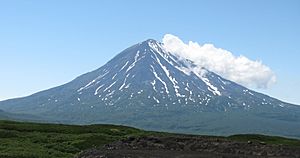
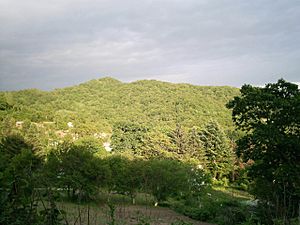
The tundra is inside the Arctic Circle. It's a tough place to live because of the permafrost, which is ground that stays frozen all year round, sometimes as deep as 1,450 meters (4,757 feet)!
The taiga is the biggest forest in the world, covering 5 million square kilometers (1.9 million sq mi). It holds 25% of the world's wood. Winters here are very cold. When the snow melts, the ground becomes a "spongy wetland" with many lakes and puddles.
The steppe stretches from Voronezh to the Kuban area. It's mostly flat land with rich, black soil called chernozem. The Volga River flows through this region, forming a delta before it reaches the Caspian Sea. The steppe eventually turns into the high mountains of the Caucasus, which are home to 6,000 different plant species.
The Kamchatka region is famous for its geothermal activity, meaning heat from inside the Earth. This has created many volcanoes, with 30 of them still active! Ussuriland has unique monsoon forests. A major mountain range there is the Sikhote-Alin, which runs for over 1,000 kilometers (620 mi) along the coast.
The World Wide Fund for Nature (WWF) has divided Russia's wildlife areas into 13 bioregions. As of 2012, Russia had 101 zapovedniks (pronounced: Zap-o-VED-nik). These are strictly protected nature reserves, covering more than 33.5 million hectares (82.7 million acres). There are also 38 national parks.
The first zapovednik, called Barguzinsky, was set up in 1916 along the eastern shore of Lake Baikal. These protected areas are very important for saving nature across Russia's diverse landscapes.
UNESCO has also recognized several of these areas as World Heritage Sites. These include the Virgin Komi Forests of the Urals, Lake Baikal, the Volcanoes of Kamchatka, the Altai Mountains, the Western Caucasus, the Curonian Spit, Central Sikhote-Alin, Uvs Lake Basin, and the Wrangel Island Reserve.
How Russia Protects Its Wildlife
Russia has laws to protect its forests and wildlife. The Forest Legislation of 1993 is the main law for managing forests. It makes sure that forests are used carefully and that rules are followed for planting new trees, protecting them, and keeping them healthy. The Federal Forest Service is in charge of this.
The Law on Protection and Use of Wildlife from 1982 helps protect game species (animals that can be hunted) everywhere except in special protected areas like the zapovedniks. Russia's Red Book lists 250 animal species and 500 plant species that are protected by the Ministry of Environmental Protection and Natural Resources. However, animals that are not game species are not always protected by these laws.
There's also a new forest code that allows private companies to lease forests for up to 49 years. This means they can use the forest resources under rules set by the government.
Plants and Fungi of Russia
In the cold tundra, the ground is covered by lichens, mosses, grasses, and flowers. For nine months of the year, these are buried under snow. Only a few twisted, small trees and bushes grow here because their roots can't get through the frozen ground.
The taiga forest is full of tall trees like spruces, firs, pines, and larch. On the forest floor, you'll find grass, moss, lichens, berries, and mushrooms.
The steppe areas are mostly farmlands and grasslands. In the Volga Delta, beautiful pink and white Caspian lotus flowers bloom across the water in summer. The Caucasus region is home to an amazing 6,000 different plant species, including many wild flowers.
Ussuriland has a unique, lush monsoon forest. Unlike the taiga, its trees and undergrowth are covered with climbing plants like lianas and vines.
Animals of Russia

Tundra Animals
Because of the extreme cold, not many animals live in the tundra. However, reindeer thrive here! They can handle temperatures as low as -50°C (-58°F), and there are about four million of them. Other animals include lemmings (small rodents), Arctic foxes, seals, walruses (near Chukotka), polar bears, and whales.
Taiga Forest Animals
The taiga forests are home to squirrels, chipmunks, voles, and lemmings. Carnivores (meat-eaters) include polecats, brown bears, lynx, wolves, foxes, wolverines, and the sable. Large deer called elk, which can be 2 meters (6.6 feet) tall at the shoulder, are also common.
Steppe Animals
Steppe animals include wild boar and about 30 other mammal species. A small antelope called a saiga antelope also lives here, but it's endangered because of hunting.
Caucasus Region Animals
In the Caucasus region, you can find two types of mountain goats called tur, wild goats called bezoar, endangered mountain sheep called mouflon, goat-antelopes called chamois, Persian leopards, brown bears, and bison. Birds include the bearded vulture, endangered griffon vulture, imperial eagle, peregrine falcon, goshawk, and snow cock.
Kamchatka and Ussuriland Animals
The rivers in Kamchatka are full of spawning salmon, thanks to the rich volcanic ash in the region. Other animals here are Kamchatkan brown bears, sea otters, and sea eagles. These sea eagles are amazing predators of salmon, with wingspans up to 2.5 meters (8.2 feet)! About 200 bird species live here, including auks, tufted puffins, and swans.
The Siberian tiger is the most famous animal in Primorsky Krai (part of Ussuriland). As of 2015, there were about 480 to 540 of them. The Amur leopard also lives here, but sadly, only about 30 exist, and poaching (illegal hunting) is a big threat to them. Other animals include wolves, sables, and Asian black bears. The Zov Tigra National Park was created in this region to help protect these amazing species.



